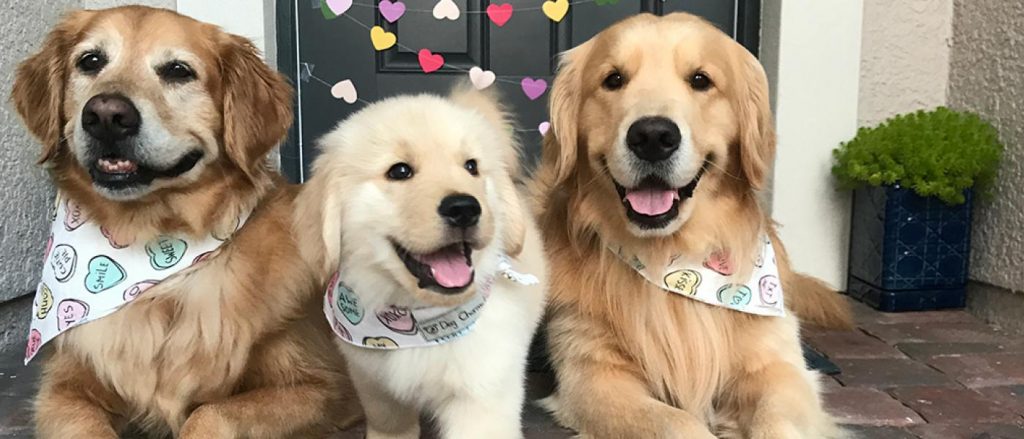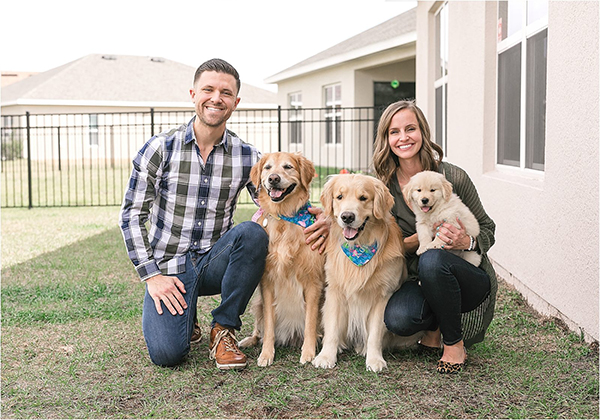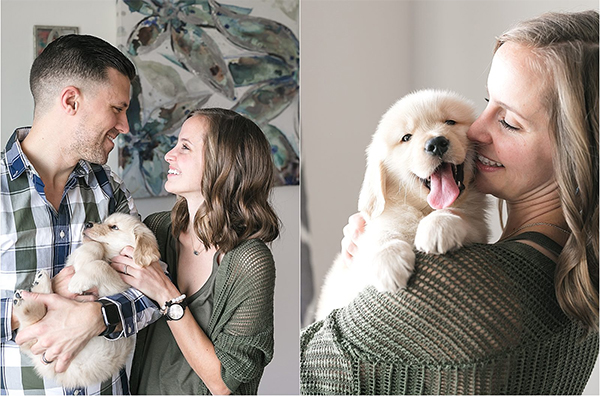How to Welcome a New Puppy with a Dog at Home

Adding a new puppy to your family is an exciting journey; one full of adventure, lessons, and laughs. And although dogs are pack-animals who are meant to live closely with other dogs, ensuring a seamless transition for each canine member can be overwhelming and confusing. But it doesn’t have to be! Our newest puppy, Kenai, is the fourth dog we have raised. Here are three things that have successfully helped our pack adjust (in the past and present) when adding a new puppy.
1. Schedule

Jeremy and Mandi with their 3 pups (left to right) Kylie (9), Kono (3) and Kenai (2 months)
Dogs crave structure in their lives, so having a consistent schedule is important. We strive to maintain our adult dogs’ day-to-day routine while balancing a puppy’s more demanding needs. Throughout the day we work to maintain mealtimes, potty breaks and exercise routines.
We overlap where we can, and work the rest around their existing schedule. For instance, even though a puppy may eat three times a day in the beginning (and an adult dog only twice), try ensuring two of those meals are at the same time. Maintaining your adult dog’s expectations and schedule offers stability and peace of mind that you are still reliable and consistent – that the new ankle biter hasn’t taken over everything.
2. Respect
In nature, raising puppies is a family ordeal. The responsibility of instilling manners, boundaries, and rules doesn’t fall solely on the mother – other adult dogs will help teach the little members of the pack how to peacefully coexist with each other.
If you trust that your adult dog is a stable, well-adjusted canine, you can learn a lot about puppy-raising by sitting back and watching her interactions with your puppy.
However, since our dogs have to figure out not only how to live with each other, but also in our human-world, sometimes our intervention can help this process.

Jeremy and Mandi with their new puppy, Kenai, a 2-month-old Golden Retriever
One way we achieve harmony in the beginning is during meal times. Since eating is a strong instinct for dogs, it offers a great opportunity for solidifying your leadership and teaching respect. Likewise, this “exercise” can provide a wonderful opportunity for bonding:
• Allow your adult dogs to begin eating first.
• As the adult dogs begin to eat, keep the puppy calm and close; where he can still see and smell what is going on, but the distance allows his body language to relay respect.
• Having the puppy wait to eat helps the adult dog reinforce her leadership, while the puppy practices healthy boundaries. Additionally, eating together encourages pack behavior, which in turn nurtures bonding.
3. Exercise

The pups are burning off some energy! Kono (left) and Kylie (right).
Like us humans, regular exercise is imperative for dogs to be happy and healthy. Getting your new puppy exercise is a delicate balancing act of protecting him prior to being appropriately vaccinated, and exposing him to the different sights, scents, and sounds of the world.
In nature, walking together is probably the most natural thing a pack of dogs participate in. They walk to seek shelter, food, water, shade and so forth.
Walking is also one of the quickest ways to develop a bond among dogs, since it is so embedded in their natural instincts. Not only that, but it drains mental and physical energy which allows a dog to find physical rest and mindful peace – which is the recipe for true contentment. (All crucial things to achieve for each dog during the adjustment!)
Carrying your pup or investing in a dog-stroller are ways you can include your puppy on a pack walk before it is safe for their paws to be on the ground. Another thing we do after the first set of vaccinations is purchase dog-safe wet-wipes, and be diligent about wiping our puppy’s paws after they have been out and about. This helps cut down on the germs and bacteria they are exposed to that may lead to infections and viruses.
Though we have made numerous mistakes over the years, our understanding of navigating the adjustment of bringing home a new puppy has grown considerably. We now feel confident in providing both our adults and puppies with everything they need to ensure a smooth transition.
Summary
To help facilitate a pawsitive transition when adding a new puppy, try implementing and following through with these three concepts:
Schedule
Maintaining your dogs’ expectations of his life through his schedule and routine allows him to feel safe and content during the major changes that come with adding a puppy.
Respect
Encourage healthy boundaries and stay committed to the rules you set for your dogs, puppy included. Implementing predicable routines during mealtimes can help nurture bonding and reinforce leadership.
Exercise
Follow through with typical exercise routines to ensure no one has pent up energy (which can lead to frustration) during the adjustment.
Try to safely include the puppy during pack walks and play times when it’s appropriate.
These three things not only bring harmony to our pack, but they help in setting the foundation for lifelong bonds among our dogs; bonds of loyalty, trust, respect and understanding – just as nature intended.




